
New England cuisine is an American cuisine which originated in the New England region of the United States, and traces its roots to traditional English cuisine and Native American cuisine of the Abenaki, Narragansett, Niantic, Wabanaki, Wampanoag, and other native peoples. It also includes influences from Irish, French, Italian, and Portuguese cuisine, among others. It is characterized by extensive use of potatoes, beans, dairy products and seafood, resulting from its historical reliance on its seaports and fishing industry. Corn, the major crop historically grown by Native American tribes in New England, continues to be grown in all New England states, primarily as sweet corn although flint corn is grown as well. It is traditionally used in hasty puddings, cornbreads and corn chowders.

A taco is a traditional Mexican food consisting of a small hand-sized corn- or wheat-based tortilla topped with a filling. The tortilla is then folded around the filling and eaten by hand. A taco can be made with a variety of fillings, including beef, pork, chicken, seafood, beans, vegetables, and cheese, allowing for great versatility and variety. They are often garnished with various condiments, such as salsa, guacamole, or sour cream, and vegetables, such as lettuce, onion, tomatoes, and chiles. Tacos are a common form of antojitos, or Mexican street food, which have spread around the world.

Cornbread is a quick bread made with cornmeal, associated with the cuisine of the Southern United States, with origins in Native American cuisine. It is an example of batter bread. Dumplings and pancakes made with finely ground cornmeal are staple foods of the Hopi people in Arizona. The Hidatsa people of the Upper Midwest call baked cornbread naktsi. Cherokee and Seneca tribes enrich the basic batter, adding chestnuts, sunflower seeds, apples, or berries, and sometimes combine it with beans or potatoes. Modern versions of cornbread are usually leavened by baking powder.

Panera Bread is an American chain store of bakery-café fast food restaurants with over 2,000 locations, all of which are in the United States and Canada. Its headquarters are in Sunset Hills, Missouri.
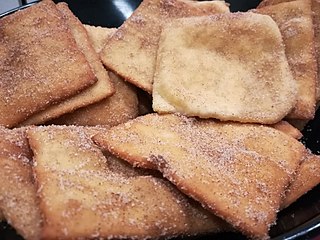
A sopaipilla, sopapilla, sopaipa, or cachanga is a kind of fried pastry and a type of quick bread served in several regions with Spanish heritage in the Americas. The word sopaipilla is the diminutive of sopaipa, a word that entered Spanish from the Mozarabic language of Al-Andalus. The original Mozarabic word Xopaipa was used to mean bread soaked in oil. The word is derived in turn from the Germanic word suppa, which meant bread soaked in liquid.
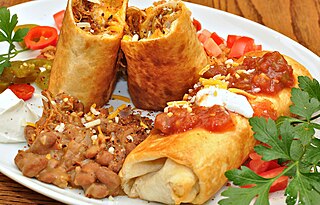
A chimichanga is a deep-fried burrito that is common in Tex-Mex and other Southwestern U.S. cuisine. The dish is typically prepared by filling a flour tortilla with various ingredients, most commonly rice, cheese, beans, and a meat such as machaca, carne adobada, carne seca, or shredded chicken, and folding it into a rectangular package. It is then deep-fried, and can be accompanied by salsa, guacamole, or sour cream.

A chalupa is a specialty dish of south-central Mexico, including the states of Hidalgo, Puebla, Guerrero, and Oaxaca.

Frybread is a dish of the indigenous people of North America that is a flat dough bread, fried or deep-fried in oil, shortening, or lard.

New Mexican cuisine is the cuisine of the Southwestern US state of New Mexico. The region is primarily known for its fusion of Pueblo Native American cuisine with Hispano Spanish and Mexican cuisine originating in Nuevo México.

Lángos is a typical Hungarian food. Today it is a deep fried flatbread, but in the past it was made of the last bits of the bread-dough and baked at the front of the brick or clay oven, to be served hot as the breakfast of the bread-baking day.
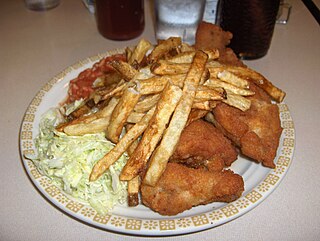
Barberton chicken, also known as Serbian fried chicken, is a style of fried chicken native to the city of Barberton in Summit County, Ohio. It is a distinctive Serbian-American style served in several mainly Serbian-owned restaurants in Barberton and nearby Norton and increasingly in other surrounding communities. The style of chicken has given the town national recognition, with some proclaiming Barberton to be the "Chicken Capital of the World" or the "Fried Chicken Capital of America."
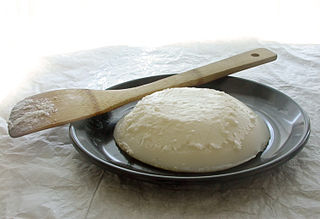
Lard is a semi-solid white fat product obtained by rendering the fatty tissue of a pig. It is distinguished from tallow, a similar product derived from fat of cattle or sheep.
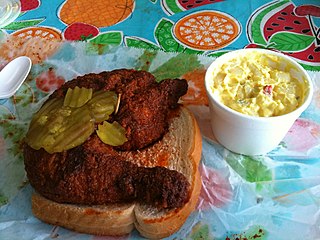
Hot chicken is a type of fried chicken that is a local specialty of Nashville, Tennessee, in the United States. In its typical preparation, it is a portion of breast, thigh, or wing that has been marinated in a water-based blend of seasoning, floured, fried, and finally covered in a paste or sauce that has been spiced with cayenne pepper. This method of preparation originates within African American communities in the Southern United States. A richly pigmented seasoning paste gives the fried chicken its reddish hue. Spice blends, preparation methods, and heat intensity vary from recipe to recipe or depending on the chef.

The cuisine of New Orleans encompasses common dishes and foods in New Orleans, Louisiana. It is perhaps the most distinctively recognized regional cuisine in the United States. Some of the dishes originated in New Orleans, while others are common and popular in the city and surrounding areas, such as the Mississippi River Delta and southern Louisiana. The cuisine of New Orleans is heavily influenced by Creole cuisine, Cajun cuisine, and soul food. Seafood also plays a prominent part in the cuisine. Dishes invented in New Orleans include po' boy and muffuletta sandwiches, oysters Rockefeller and oysters Bienville, pompano en papillote, and bananas Foster, among others.
Tatanka Wanbli Sapa Xila Sabe Means is a Native American actor and comedian, of Oglala Lakota, Omaha, Yankton Dakota, and Diné descent. He is best known for his roles in Killers of the Flower Moon and The Son.
More Than Frybread is a comedic pseudo-documentary that was released in 2012 which was directed and written by Travis Holt Hamilton. The 96-minute comedy premiered at the Harkins Valley Art Center on May 4, 2012. This film stars Tatanka Means, Greg Fernanadez and Mary Kim Titla. Wanting to celebrate and showcase Native cultural tradition, Hamilton says “More Than Frybread is a comedy to showcase nationalism and inter-tribal competition”

Sean Sherman is an Oglala Lakota Sioux chef, cookbook author, forager, and promoter of indigenous cuisine. Sherman founded the indigenous food education business and caterer The Sioux Chef and cofounded with then-partner Dana Thompson the nonprofit North American Traditional Indigenous Food Systems (NĀTIFS). He received a James Beard Foundation Leadership Award and his 2017 cookbook, The Sioux Chef's Indigenous Kitchen, won the 2018 James Beard Award for Best American Cookbook. In 2022 the restaurant he co-owned with Thompson, Owamni, won the James Beard Award for Best New Restaurant.

Lois Ellen Frank is an American food historian, cookbook author, culinary anthropologist, and educator. She won a 2003 James Beard Foundation Award for her cookbook Foods of the Southwest Indian Nations, the first cookbook of Native American cuisine so honored.
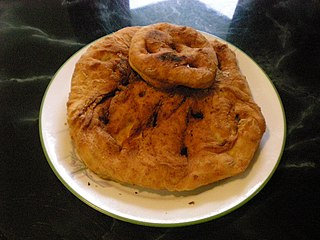
Bannock, skaan, Indian bread or frybread is found throughout North American Native cuisine, including that of the Inuit of Canada and Alaska, other Alaska Natives, the First Nations of the rest of Canada, the Native Americans in the United States, and the Métis.
















